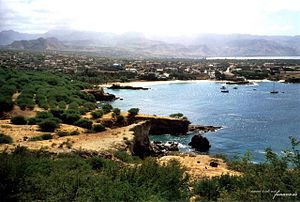Baía de Tarrafal
| Baía de Tarrafal | |
|---|---|

Tarrafal Bay
|
|
| Location | West of Tarrafal, Santiago, Cape Verde |
| Coordinates | 15°17′01″N 23°45′37″W / 15.2837°N 23.7602°W |
| Max. length | 2 km (1.2 mi) |
| Max. width | 1 km (0.62 mi) |
| Average depth | 5 m (16 ft) |
Baía de Tarrafal or Tarrafal Bay is a bay on the northwest coast of the island of Santiago in Cape Verde just west of the town of Tarrafal and inside the Atlantic Ocean. Its length is 2 km and its with is 3 km. Beside the bay in the east is Tarrafal Beach (Praia de Tarrafal) and alongside the northern part the foot of Monte Graciosa. The bay receives its name to the town of Tarrafal. As to other Tarrafals in Cape Verde, the name refers to tamarisk plantations (genus Tamarix) grown in the area. The northern portion forms a part of Monte Graciosa Natural Park.
The bay features a beach 300 meters long located north of the city, the remainder of the bay has its shores with rocky cliffs and ledges. Ribeira Fontão empties in the mid-center part, it flows north of the ledges of Tarrafal and that portion forms a boundary with the Monte Graciosa Natural Park. Hotels and villas lies in the east and the south of the bay. Ponta Preta is in the north of the bay, southeast on the mountain foot is a lighthouse of the same name The beach featured an abandoned fortress and a kiosk, also a stone house is alongside the beach. The beach are surrounded by Capeverdean palm trees..
The bay are surrounded since the 2010s by a forest of groves especially mango trees.
Fishing is common in the bay.
On September 27 and 28, 1941, though Portugal never took part in World War II, an action in the bay which was part of the Battle of the Atlantic took place, it battled a British submarine, the Clyde and 3 German submarines, the battle was inconclusive, the U-67 was damaged.
Numerous fauna mostly endangered dominate the bay as well as under the sea surrounding the point. Marine fauna founded in the waters include the goose barnacle Pollicipes caboverdensis and the coral Balanopsammia wirtzi, the only species of the genus. Both of these were named in the first years of the current decade. Fishes founded within the promontory include the Cape Verde basslet (Liopropoma emanueli) and the Two-banded seabream (Diplodus prayensis).
...
Wikipedia
